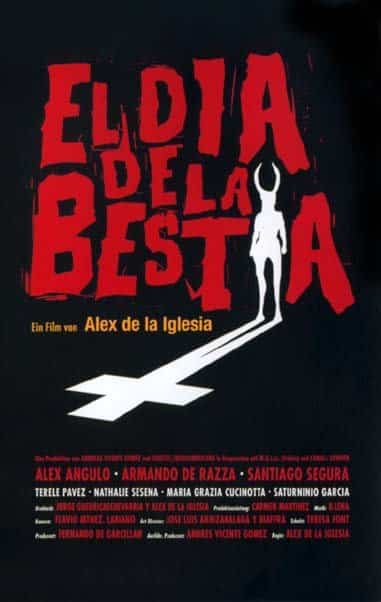
El Día de la Bestia (Day of the Beast) [Álex de la Iglesia, 1995]
Tired of conventional horror movies? Fed up by those inadvertently hilarious films about Satan and his crew? Well, you’d better try this outrageous comedy made by Alex de la Iglesia, a true filmmaking hooligan who has perpetrated some of the funniest and most shocking films of recent Spanish cinematography. “El Día de la Bestia” is, of course, about the Apocalypse, which allegedly was about to take place in Madrid, 1995. A crazed priest and a no less crazed heavy metal fan are struggling to find out when the ominous event is going to take place. Throughout this frantic adventure you can take a look at some of Madrid’s most emblematic places, including Torres Kio -¡a symbol of the Fallen Angel!- and the huge Schweppes advert hung in Callao. A ridiculously funny cult film not to be missed.
¿Qué he hecho yo para merecer esto? (What Have I Done to Deserve This?) [Pedro Almodóvar, 1992]
For me –as for many- Almodóvar’s career reached some of its peaks during the nineties, when he managed to find a perfect balance between his funny and grotesque but anarchic early films and the more ambitious narrative he later developed; “What Have I Done to Deserve This?” is one of the funniest portraits of a dysfunctional family ever committed to film. A ensemble movie, crammed with black humour, it follows the unconventional life of a housemaid facing the most disturbing facets of the modern world –in its bizarre Spanish incarnation-, surrounded by an astounding gallery of far-out but soulful characters. Needless to say, this amazing comedy takes place in Madrid, although you are advised not to take it as a representative or realistic slice of life in the city.
Surcos (Furrows) [José Antonio Nieves Conde, 1951]
One of the most exceptional Spanish movies ever filmed –in every sense-, this film is a rara avis. Filmed during Franco’s regime, its director, Nieves Conde, was once a man of the regime who eventually became disaffected with it; “Surcos” makes this pretty clear, as the film draws heavily on Italian neorealism of that time and the parallelisms between it and the works of De Sica and Rossellini are apparent. Nieves Conde depicts the tribulations of a low-class rural family that emigrate to Madrid in pursuit of a brighter future, although their path is far from easy and they soon become victims of exploitation and misery. Not only does this film have a brilliant narrative and top notch natural acting, but it also faithfully portrays how Madrid was during that time.
El Verdugo (The Executioner) [Luis García Berlanga, 1963]
Critically acclaimed, “El Verdugo”, as well as the aforementioned “Surcos”, is a must-see for those who want to achieve a better understanding of Spanish society during the dictatorship and the misery and moral dilemmas that took place during that time and in this case in particular, the death penalty, Berlanga vividly depicts the life of a young man who is the son of an executioner; he has to deal with his father’s retirement and his unwillingness to follow in his professional footsteps. Leaving aside Berlanga’s courage in dealing with such a hot issue as the death penalty was during that time, he also managed to humanize his characters in a brilliant way; instead of blaming it on the hangman, he chose to use the story as a vehicle to make a sharp social diagnosis (like “El cochecito”, it was also written by Rafael Azcona). Furthermore, “El Verdugo”’s final scene is one of the most outstanding ones in the entire story of the seventh art. And, for those interested in knowing what Madrid was like during the early sixties, the film is rich in images of its streets and cafeterias, and also faithfully depicts family relationships.
El cochecito (The Little Coach) [Marco Ferreri, 1960]
Although Ferreri is, of course, an Italian director, some of his early films were produced in Spain; among these, the most remarkable might be “El cochecito”, the fruit of a collaboration between him and Rafael Azcona, one of the cleverest screenwriters to ever grace a screen. As a result, this film portrays an older man who becomes obsessed with buying a little coach –of the kind that serves as a vehicle for disabled people- and, for that purpose, sqanders his wealth and his family’s. The crux of the matter is that our main character is not a disabled person, although he envies the comfortable, lazy life of his friends who truly are, and wants to have the vehicle to team up with them as equals. From this witty but bizarre starting point, the author builds up a deep drama punctuated by strokes of dark humour about the childishness of the third age and the well known Spanish picaresque, but he also addresses social issues of the time and even the role that technology plays in our lives –the duality between serve or to be served. And, like every other movie in this article, it provides a great view of how Madrid looked at the time and a bitter portrait of Spanish society –and human nature, by extension.
We hope you have enjoyed these reviews; remember to follow International House Madrid’s blog and our Facebook page to learn more about language and to get the most out of your visit to Madrid.

